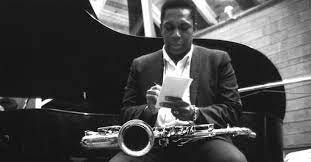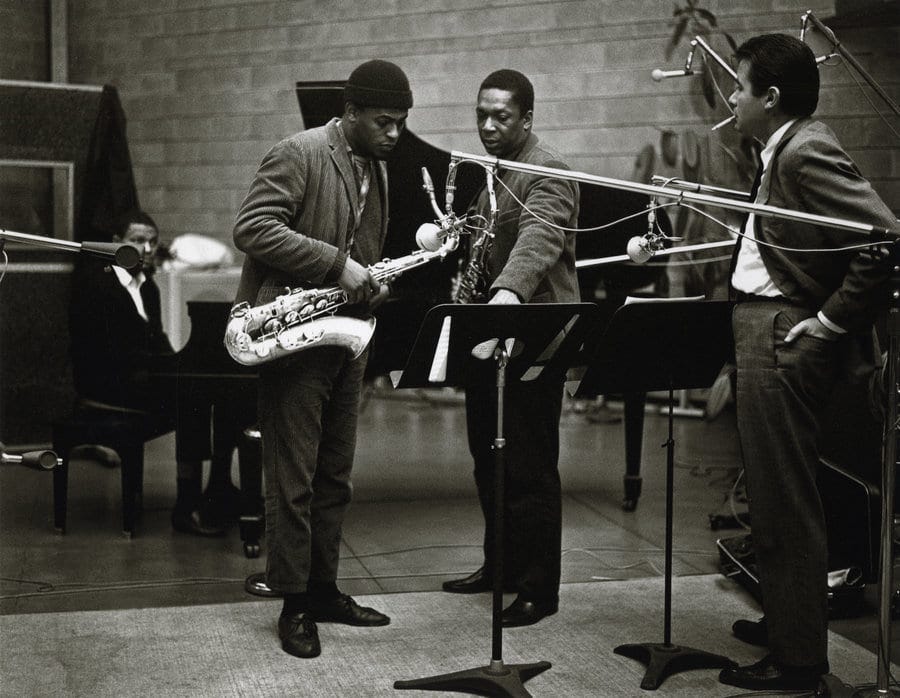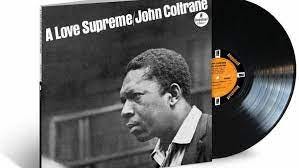A Love Supreme/A Love Supreme/A Love Supreme/A Love Supreme/A Love Supreme…
Sounds Good! Sounds Good! Sounds Good! Sounds Good! Sounds Good!
My brother arrived home from university with The Stardust Session and A Love Supreme. These two albums were life changing. I carried on playing sport, going to school. In so many ways life was the same – but life was never really the same for me after hearing The Stardust Sessions and A Love Supreme. Those albums were my introduction to John Coltrane.
It changed my expectations for music, for what music can do. For what it can be. For how it can make you feel.
A Love Supreme is an album you can really get inside. I find myself in the album often – hardly a week goes by when I don’t play it or at least a track from it. Most often I listen to the whole album – it is so very much a complete album – but you cannot get a better introduction to the sound and vitality of a whole album, an-album-in-snapshot, than A Love Supreme’s opening track.
It’s a suite. The album is one whole piece – segmented into four parts. But it’s one thing.
Hearing A Love Supreme for the first time blew my mind. Elvin Jones is so colourful, daubing at the toms, splashing across the cymbals. McCoy Tyner plays bold, elegant piano. Jimmy Garrison’s bass sound is huge. The perfect moans behind Coltrane’s dulcet tones.
We sat and listened to the album. And instantly I wanted to hear it again. So that is what I did – pressed play and sat back to again take it all in. It was all at once like being inside a very good book or film and yet the cup was just spilling over as I tried to drink in this thing; this so-huge sound.
I’ve been listening to A Love Supreme for more than half my life. It’s travelled with me – it’s been a comfort. It’s been so much more than just an album.
From A Love Supreme and The Stardust Sessions (a compilation of earlier Coltrane albums) I collected as much as I could find. Original albums, compilations, live records, box-sets, sessions featuring Coltrane, work where he was the sideman but it’s now rebranded to pitch him as the star.
Sometimes I’ll spend a big part of a week working through some of the favourites: Giant Steps, OM, Ascension, Live a the Village Vanguard, Soultrane, The Complete Africa/Brass Sessions. And there are another half-dozen I could name. At least.
One album leads you to another – they hook you in from the gorgeous ballads (hear where he takes Stardust or his own Naima) through to the several choruses that form the unstoppable force that is Chasin’ the Trane. Then there was the free jazz he helped to pioneer. The amazing thing I find, still, in working through all this material (and actually it’s not really a chore at all, so “working” is the wrong word) is that there was no one definable Coltrane Sound. There were several sounds. But he put himself entirely in to all of them. So you can always know that it’s him.
What I mean by that is the very early playing was often slightly shaky, not fully formed. He lacked confidence as a sideman to begin with. Then he started to develop the “sheets of sound” approach to soloing – and the ability to play several notes at once helped him to layer his sounds, peppering his solos with ideas. As he moved in to being a leader, releasing albums under his own name, running that incredible quartet that peaked with A Love Supreme, he was in charge not only of his sound but a very distinctive band sound.
Check out this version of Softly As In A Morning Sunrise – you don’t hear Coltrane at first but you know who it is (in the band) as you spot a lovely solo from Tyner on piano. When Coltrane comes in and the brushes are dropped so that sticks can pick up the swing it’s on – it is so totally, obviously Coltrane. And it is so totally, obviously The John Coltrane Quartet; one of modern jazz’s greatest groups.
The Coltrane that blew so furiously, so passionately across Live at the Village Vanguard (1961) and the albums that followed had to find its way out the other side of drug addiction, of crippling self-confidence issues, battling with demons and emerging as the life-force that kept its owner both free to explore sounds and impossibly shackled to music.
As the owner of the Coltrane sound – something so influential and yet so inimitable – John Coltrane became one of jazz’s true legends.
He was significant as a member of one of the great Miles Davis groups. Davis had kicked his habit and required Coltrane to do the same. As Coltrane was fired and moved around to work with other huge names, Duke Ellington and Thelonius Monk for example, he did kick the habit. He found peace through religion; or at least attempted to. And he emerged with the Giant Steps album in 1960, which is his real debut as a leader. He had recorded a couple of albums already but Giant Steps is the start of the defining Coltrane work. It is, to this day, a stunning album of all original compositions – at least half a dozen of them (almost the entire album) became jazz standards.
And then from 1960 to 1967 the workload is hard to fathom – the amount of music is close to overwhelming, particularly given the stylistic variations. He showed skill at interpreting pop tunes (My Favourite Things) and ballads. And then moving past modal jazz and straight ahead/bop styles to work without structure, to work at free music, to record duets/dialogues with only himself and a drummer; to perform as a solo saxophonist, spitting and coughing and spluttering from the horn.
The other thing about the Coltrane sound is that he moved across instruments – these days the soprano saxophone has been all but ruined by Kenny G but in Coltrane’s hands (and mouth) it was a magic stick.
Where someone like Sonny Rollins remained a tenor player only, John Coltrane had success with more than one type of sax; it was part of his search for a sound, part of his quest, part of the improvisation and innovation.
The Coltrane sound was deep inside the man that made it – and it was fluid. It was a sound he was searching for his whole life. And it kept him alive as long as it was able, as long as he was able to keep up with attempts to pin down that sound.
Liver cancer took him from this world when he was just 40 (in 1967). It makes his work all the more remarkable when you think of what is there – to still discover now – from the years when he was a leader. He started releasing that incredible run of albums when he was 33. In seven years he made so many different kinds of jazz that have left an indelible mark, that are still influential but so hard to replicate. There is, to this day, no one saxophonist that sounds quite like John Coltrane but there are so many that owe such a huge debt to his playing, to his writing – to that search he maintained, looking for a sound. His sound.
Coltrane: The Story of a Sound by Ben Ratliff is one of my favourite books about John Coltrane. But there are a few – I’ve read a couple of books just dedicated to A Love Supreme and I’m just into a book, now, about religion and Coltrane; about John’s search for God and his expression of that through his horn. This is a subject that has interested me since I first heard the album and read the liner notes – the whole thing (music and text) a prayer and love-letter. To God. I’m not a religious person at all. But I’m searching for my spirituality – and I’m interested in seeing and hearing people’s expression of that whether overtly religious or not. I love that line in the Bob Dylan poem, Last Thoughts on Woody Guthrie, about how you find God in the church or your choice and you can find Woody Guthrie in the Brooklyn state hospital. He goes on to say that you’ll find them both at the Grand Canyon at sundown.
I listen to A Love Supreme most weeks. Just yesterday I finished the shift, it was time to head home. All podcasts exhausted – for now. And no new music would do the long walk justice. So it was to A Love Supreme. The whole album went by as I walked – I followed it up by listening to Naima and Alabama. And I was home. John Coltrane. He’s there with me always – in so many ways. But so right at the end of the day. A Love Supreme swings hard. And it rocks hard too. In its way. It’s just bursting with heart. And soul. And though Coltrane is telling us that he’s found something. The thing. The one. The search is still on. His redemption was never quite complete. Never had ethe chance to fulfil it. I think about that a lot. I wrote poems about it. About hearing Coltrane for the first time. The gratitude. To my brother. And also something happened when I became older than the age Coltrane was when he wrote and performed A Love Supreme. I tried to get that down in a poem too.
But for all that I’ve read about Coltrane – and the times I’ve tried to write about him too – there’s really no substitute for listening to him. There are a half dozen albums you should have and hold dear. Maybe more. But today let’s start with one. Play A Love Supreme now – if you never have. Play it right now even if you’ve heard it, even if you know it well and love it and don’t think you need to hear it again. You do. You always do. It will always work for you.
And, awkward segue, but, lol, if you are looking for something else – I got you covered with the regular weekend playlist.










The Best.